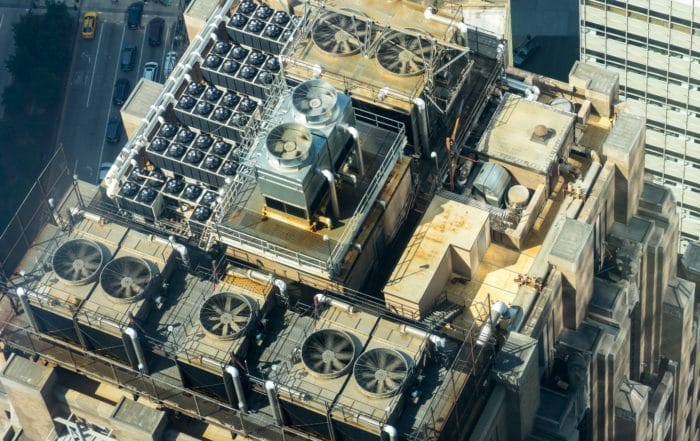Coronavirus Prevention – Is Your Building Ready to Reduce COVID-19 Transmission Risk?
July 21, 2020 / 8 mins read

With the decrease in COVID-19 cases, businesses are looking at reopening their doors. The threat of infection isn’t over yet, however. Companies need to be aware of the danger that the virus still poses to highly concentrated work areas. To help facilities that intend to reopen, ASHRAE has set out a building readiness guide as a framework for measuring their progress. Coronavirus prevention is of the utmost importance at this stage of the process. Here we seek to present a 3-stp approach towards restarting the building outlined below.
STEP 1: Assessment
Before a company can do anything regarding its COVID-19 readiness in terms of HVAC, it needs to be aware of its current situation. Ideally, the business would hire professionals skilled in HVAC to do an overall assessment of the building’s systems. Such professionals include licensed engineering professionals (PE), certified commissioning agents (CxA) or certified testing, adjusting, and balancing (TAB) service providers. Depending on what the building’s current equipment looks like, upgrades or reinstalls may be necessary. The professionals would need to start by inspecting conditioned spaces – airflow, temperature, and humidity levels, as well as the condition of mechanical infrastructure such as fan systems. This analysis will form a baseline for measuring performance. Ideally, at this stage, the professionals should generate a static humidity and pressure profile of various locations before installing the upgrades.
STEP 2: Comparison and Potential Redesign
If the system goes through this process and is still unable to meet the requirements for air quality, then a complete redesign may be necessary. Consult a professional to do a step-by-step breakdown of how the building’s HVAC mitigation strategies should proceed. Before the upgrade occurs, businesses can look at having portable HEPA filter units in areas where there’s a large concentration of people.
Elements to Consider in Coronavirus Prevention for Buildings
Occupant health and comfort within a building relies on a handful of critical factors, including:
1. Ventilation
Ventilation in buildings can severely affect the quality of life of people within the structure. Healthline notes a disease termed Sick Building Syndrome (SBS), which stems from a building having poor indoor air quality. Now that COVID-19 is a concern, the need for better ventilation within the premises is necessary.
Assessing a building’s ventilation comes with examining the carbon dioxide concentration within the area. Higher levels of carbon dioxide suggest poor ventilation or underperforming HVAC systems. There are several methods that businesses can look at for increasing ventilation within a space. Demand Control Ventilation (DCV) can be used to adjust the ventilation rate automatically. Alternatively, increasing the amount of fresh air pumped into the HVAC system may bring about a positive change. Each of these can help to deal with the menace of COVID-19 within a building.
2. Filtration
As the National Air Filtration Association (NAFA) mentions, many buildings that run MERV level 8 filtration systems in keeping with the old ASHRAE standards aren’t able to properly deal with the virus responsible for coronavirus. The recommendations suggest that, for a building to be considered ready for reopening, it should institute higher level MERV filters to trap particles of a smaller size, and hopefully reduce the spread of the disease.
Air may not be as pure as you think it is. Contaminants can show up in the air and bring down its quality. Filtration systems are designed to separate this suspended particulate matter, pathogens, and other material from air, raising the air quality. Assessing a building’s HVAC filtration starts with a manual inspection of the filters that make up the HVAC system. On completion of the examination, the next step involved testing the airflow and resistance within the HVAC system. These tests should be done with both dirty and clean filters to make a comparison. To reduce COVID-19 transmission, companies should be looking at upgrading their filters to a minimum of MERV-13. Alternatively, a building can choose to install HEPA filters (equivalent to MERV levels 17-20). UV light filters can also play a part in controlling the spread. UV Germicidal Irradiation is currently under consideration as a method in coronavirus prevention.
3. Humidity Control
Humidity plays a part in air quality, just like other factors. In buildings that have higher humidity values, there tends to be increased growth of fungus and mold. Spores from these sources can cause respiratory problems if they become too concentrated, or if individuals are allergic to them. High humidity may also lead to damage in electrical sensors and equipment. Measuring humidity within a building relies on surveys of the occupants as well as a Building Management System (BMS) survey. Visual evidence of uncontrolled building humidity includes the presence of mold or fungi growing on the building or condensation buildup in the structure’s colder areas. To deal with humidity problems, a building can retrofit its AHU to dehumidify the air flowing through it. Building control modification is also an option, as well as adding dehumidification elements as part of the air circulation system.
4. Develop and Implement Change Management Plans in Response to COVID-19
As COVID-19 is such a unique state of affairs, businesses may need to inform occupants of the steps they have taken with coronavirus prevention measures. Some frequent additions to existing O&M plans that deal specifically with the coronavirus pandemic include:
- A strict social distancing plan should be implemented in areas of high concentration or traffic (such as cafeterias).
- Constant communication with occupants through emails or newsletters is necessary to keep transparency and trust alive.
- Protocols for dealing with medical situations, such as if an occupant starts showing symptoms of the virus.
- Hand sanitizer stations should be set up around the building for easy distribution.
- Cleaning in specific areas should be more extensive. Evidence suggests that soap breaks down the virus’s structure.
- Single-use disposable face masks should be provided for use at convenient locations.
Making a Building Coronavirus-Ready
While it’s good to have a general idea of how a building should prepare itself for reopening, this is not a one-size-fits-all approach. Different structures have different needs regarding their occupancy, discipline, and industry. Your building is unique, and trying to deal with it using a generic approach will not end well. At Mintropy, we offer solutions starting from assessment to redesign. Our engineers have experience in developing the most optimal solutions to keep within our clients’ needs and budgets. Contact us today, and let’s help you get your building ready for reopening!
Need help with your project? Let’s get in touch!
Lorem ipsum dolor sit amet, consectetuer adipiscing elit.

